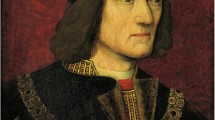Abstract
At the battle of Bosworth Field (22 August 1485), Richard of Gloucester, last Plantagenet King of England, was killed while on foot, having abandoned his horse in a mire. The skeletal remains now accepted as being those of Richard III show a series of blows to the head, ten in all, from one or more assailants, using a combination of sword and dagger to inflict fatal injuries. After death, the pelvis of the dead king was also hacked, presumably while the body was led away from the battle, slung in ignominy over a horse. The skull however was not further insulted. The report by the archaeopathology team makes riveting reading, complete with X-ray images of the skull and its jaw. The research team report their findings in Lancet (from which my paraphrase is drawn) with admirable forensic, empiricist clarity,1 bringing us satisfactorily the ‘touch of the real’ long held out as a kind of holy grail of historicist inquiry of many kinds.2 Popular culture, medical and police TV series have prepared us well for the hypnotic force of this kind of analysis. To know how Richard died, we must examine his physical remains. This can be the only way to irrefutably establish the ‘truth’ of Richard’s death. The successful analysis of these remains is of course a brilliant team solution to a long debated issue. How did Richard die? What became of his body later?
Access this chapter
Tax calculation will be finalised at checkout
Purchases are for personal use only
Preview
Unable to display preview. Download preview PDF.
Similar content being viewed by others
Notes
Dr Jo Appleby PhD, Prof. Guy N. Rutty MD, Prof. Sarah V. Hainsworth PhD, Robert C. Woosnam-Savage BA, Prof. Bruno Morgan PhD, Alison Brough PhD, Richard W. Earp MEng, Claire Robinson MSc, Turi E. King PhD, Mathew Morris MA and Richard Buckley BA, ‘Perimortem Trauma in King Richard III: a Skeletal Analysis’, The Lancet (17 September 2014) , DOI: 10.1016/S0140–6736(14)60804–7 (accessed 25 September 2014); see also Richard Buckley, Mathew Morris, Jo Appleby, Turi King, Dierdre O’Sullivan and Lin Foxhall, ‘The King in the Car Park: New Light on the Death and Burial of Richard III in the Grey Friars Church, Leicester, in 1485,’ Antiquity 87 (2014): 519–538. http://antiquity.ac.uk/ant/087/ant0870519.htm> (accessed September 25 2014).
See, influentially, Stephen Greenblatt, ‘The Touch of the Real,’ Representations 59 (Summer, 1997), 14–30.
Kenneth Tynan, He That Plays the King (London: Longmans, Green, 1950), 35.
Editor information
Editors and Affiliations
Copyright information
© 2015 Mark Houlahan
About this chapter
Cite this chapter
Houlahan, M. (2015). Afterword. In: White, R.S., Houlahan, M., O’Loughlin, K. (eds) Shakespeare and Emotions. Palgrave Shakespeare Studies. Palgrave Macmillan, London. https://doi.org/10.1057/9781137464750_23
Download citation
DOI: https://doi.org/10.1057/9781137464750_23
Publisher Name: Palgrave Macmillan, London
Print ISBN: 978-1-349-69074-9
Online ISBN: 978-1-137-46475-0
eBook Packages: Palgrave Literature CollectionLiterature, Cultural and Media Studies (R0)




